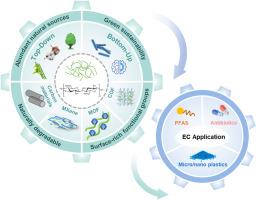纳米纤维素功能材料对新兴污染物的高级吸附和去除:绿色策略和分析观点
IF 12
1区 化学
Q1 CHEMISTRY, ANALYTICAL
引用次数: 0
摘要
工业和社会活动加剧所产生的新污染物的扩散对全球生态系统和公众健康构成重大威胁。为了应对这一全球性挑战,基于纤维素的功能材料正在获得牵引力。其独特的生物相容性和可调节的功能使其成为可持续发展和循环经济之间的关键环节。纤维素与下一代纳米材料(碳纳米材料、MXene、金属有机框架和共价有机框架)的战略性杂交正在推动创新,为ec的检测、捕获和去除提供可持续、经济、低碳的解决方案。本文综述了纤维素复合材料在ECs管理中的应用,包括纤维素的合成、功能化策略以及ECs的分析和去除机制。最后,我们批判性地评估了与材料限制、可扩展制造以及耐久性和可控降解之间的平衡有关的持续挑战,同时为未来的智能监测和修复系统提出了战略研究方向。本文章由计算机程序翻译,如有差异,请以英文原文为准。

Nanocellulose functional materials for advanced adsorption and removal of emerging Contaminants: Green strategies and analytical perspectives
The proliferation of emerging contaminants (ECs) from intensified industrial and social activities poses significant threats to global ecosystems and public health. In response to this worldwide challenge, cellulose-based functional materials are gaining traction. Their unique biocompatibility and tunable functionality position them as a crucial link between sustainable development and the circular economy. Strategically hybridizing cellulose with next-generation nanomaterials (carbon nanomaterials, MXene, metal organic frameworks, and covalent organic frameworks) is driving innovation toward sustainable, cost-effective, and low-carbon solutions for ECs detection, capture, and removal. This review systematically investigates cellulose composites for ECs management, covering cellulose synthesis, functionalization strategies, and mechanisms of ECs analysis and removal. Finally, we critically evaluate persistent challenges pertaining to limitation of materials, scalable manufacturing, and the balance between durability and controlled degradation, while proposing strategic research directions for future intelligent monitoring and remediation systems.
求助全文
通过发布文献求助,成功后即可免费获取论文全文。
去求助
来源期刊

Trends in Analytical Chemistry
化学-分析化学
CiteScore
20.00
自引率
4.60%
发文量
257
审稿时长
3.4 months
期刊介绍:
TrAC publishes succinct and critical overviews of recent advancements in analytical chemistry, designed to assist analytical chemists and other users of analytical techniques. These reviews offer excellent, up-to-date, and timely coverage of various topics within analytical chemistry. Encompassing areas such as analytical instrumentation, biomedical analysis, biomolecular analysis, biosensors, chemical analysis, chemometrics, clinical chemistry, drug discovery, environmental analysis and monitoring, food analysis, forensic science, laboratory automation, materials science, metabolomics, pesticide-residue analysis, pharmaceutical analysis, proteomics, surface science, and water analysis and monitoring, these critical reviews provide comprehensive insights for practitioners in the field.
 求助内容:
求助内容: 应助结果提醒方式:
应助结果提醒方式:


